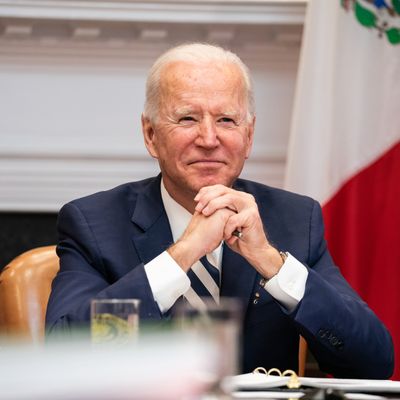
Joe Biden’s pique built slowly during his morning workouts. He likes to watch the breakfast-time political news shows — Morning Joe, New Day — while he exercises before descending to the Oval Office, and he’d noticed their tone shifting this spring. He kept quiet for a few weeks as he surfed on solid approval ratings and decent economic news following the passage of his COVID-relief legislation, but his frustration surfaced early this month during a speech in Tulsa. Attention had been building on his infrastructure proposals. “I hear all the folks on TV saying, ‘Why didn’t Biden get this done?’” he asked, looking slightly incredulous. “Well, because Biden only has a majority of, effectively, four votes in the House and a tie in the Senate, with two members of the Senate who vote more with my Republican friends!”
It was a swipe at West Virginia’s Joe Manchin and Arizona’s Kyrsten Sinema, fellow Democrats who Biden needs to support basically everything he does, and it was as uncharacteristic as his sudden lapse into punditry. Yet to students of the Washington Narrative, it made some sense. This is the season when the nation’s broadest and darkest political trends finally and publicly crashed into Biden’s famously large ambitions — Republican recalcitrance matched by the stubbornness of a handful of moderate-to-conservative Democrats who insist either that the world is far less aflame than the president believes or that he’s going too far down a liberal path. In either case, they figure, he needn’t be in such a rush to pass these particular priorities.
The last few weeks have presented an undismissable parade of evidence that Biden’s path to fulfilling his expansive agenda is, at best, winding.
On the same Tuesday early this month that his infrastructure talks with a Republican Senate negotiator fell apart — not long after Tulsa — a bipartisan gun-control effort unraveled as well. This was just after Manchin confirmed in an op-ed that he wouldn’t support a sweeping voting-rights measure while doubling down on his opposition to getting rid of the Senate’s legislative filibuster, a rules change that would make it easier for Democrats to pass their bills unilaterally. Soon, liberal senators started saying they were anxious for progress on climate bills, all while red-state legislatures — some of which are carefully redesigning their electoral maps ahead of next year’s midterms — pass laws making it harder to vote. In a recent private briefing for Democratic senators, party super-lawyer Marc Elias warned they might be out of power for decades if they didn’t stop what was happening in the states, one staffer familiar with the presentation told New York.
You might be excused for finding all this pretty jarring if you haven’t been paying close attention in the time since Biden signed his historic COVID bill earlier this year. You might even be suddenly alarmed if you were still holding out hope for broader reforms to democratic procedures, including the filibuster, to usher in a new progressive era. “Maybe I’m so cynical that sometimes I don’t see the forest for the trees, but I have a hard time imagining that there’s any part of his agenda that’s going to be passable at this point,” one exasperated Senate aide in this camp told me last week. From this perspective, it would be understandable if Biden decided to pivot his attention to things he could actually control, like executive orders and relations with the rest of the world.
But none of this grim circumstance, really, is new — nevermind the TV chyrons about Biden’s “HALTED AGENDA.”
Biden himself raised expectations last spring as a candidate, when Democrats looked likely to have wide majorities in the Senate and House, and he started comparing the nation’s plight to the one it faced when FDR took office in the early phase of the Great Depression. Yet Roosevelt was greeted by a Congress overwhelmingly controlled by his own party. Biden’s political math is much different, and since few people around him ever expected Republicans to go along with most of his grand plans, his margin for error as president has always been nonexistent. “Broadly, what’s playing out in public in the past weeks is just what’s already been playing out in private,” another top Democratic Senate staffer shrugged. The meltdown of Biden’s infrastructure negotiations with West Virginia Republican Shelley Moore Capito “wasn’t this ‘OMG, the world is changed!’ moment,” said the staffer. “It was one thing to know this is the direction things are going, and another for it to be said out loud.” Ditto for when a bipartisan group of senators then picked up on a separate infrastructure negotiation of their own this week.
Candidate Biden had spoken of movement not just on infrastructure and COVID relief but of an immigration overhaul, environmental investments, a higher federal minimum wage, police reform, and gun control, to start. Hopes to pass any of these in regular Senate processes — which would require at least ten Republican votes — have realistically already been dimmed for months. Without sufficient appetite in the Democratic caucus to nuke the filibuster, Puerto Rico or D.C. statehood look unlikely to move anytime soon, either. That Manchin — the Democrat least likely to stick to the party line — now chimed in again by downplaying his willingness to use budget reconciliation, a trick to pass spending bills with a simple majority, was just icing on the unappetizing cake for Biden. It didn’t come as a surprise, though: Manchin had been saying versions of this for months, including to people around Biden — with whom he has a mutual understanding much better than the one he shared with Barack Obama.
And still, the mood inside the White House is more frustrated than despairing.
Biden has been encouraging the second wave of bipartisan infrastructure talks even though some powerful progressive Democrats refuse to support them. He and his aides are quick to point out they’re doing whatever they can unilaterally to clean up Donald Trump’s messes inside federal agencies and abroad, while now distributing vaccines around the world and negotiating new global minimum tax rates. Even on the Hill, they like to note, there’s been progress on important matters — competitiveness with China, water infrastructure — that just don’t get top billing.
To those around Biden, the drumbeat to speed up his high-profile legislative calendar is a product of analysts’ and progressives’ skewed senses of normalcy. These things take time. “Trump withdrawal, especially among editors who live on Twitter the way some people once lived on MySpace, leads to occasional silliness,” said one person close to the White House, referring to stories in recent weeks about liberal pressure on Biden to ditch the bipartisan negotiations in favor of trying to somehow jam through a party-line vote or switch to a new focus altogether. (Julián Castro recently warned the Washington Post, “Time is running out for the administration to get big, significant things done.”)
Manchin and Sinema would presumably vote against that kind of maneuver, say senior Democrats, so they can’t even try it. And it would ruin Biden and Chuck Schumer’s plan to demonstrate to the American people — and to Manchin, who understands his colleagues’ gambit — just how obstructionist the Republicans are being, by trying to pass repeated popular measures and seeing them fail at GOP hands. See: the proposed commission to investigate the January 6 insurrection.
Still, Democrats on the Hill saw Schumer’s recent decision to schedule a vote on their voting-rights proposal for July as an acknowledgement that some kind of infrastructure agreement might not be wrapped up until August at the earliest thanks to the Republican strategy of feinting toward bipartisanship without fully committing — which is muddling the Democratic messaging. “Republicans’ strategy works! It’s always worked,” grumbled one frustrated former longtime Biden adviser. (We spoke shortly before the latest across-the-aisle agreement seemed poised to inch forward. Its next step: evaluation from skeptical climate-first progressives.)
This, though, has been true all along and certainly since Biden took office. A few days after Manchin’s latest op-ed — which set off yet another news cycle about the senator’s singular leverage but didn’t really shed much new light on his thinking or tactics — I caught up with Dan Pfeiffer, a former senior communications adviser to Obama. He’d just written about the unwelcome return of what the political scientist Brendan Nyhan calls “the Green Lantern Theory” of the presidency, which is when pundits think more could be done if the president just worked a bit harder or experimented with new tactics. This time, the popular story line had gone “from ‘Biden-as-FDR’ to ‘Biden agenda stalled,’” Pfeiffer said, “even though the underlying data points had not changed.”
Biden’s bigger annoyance is that he can’t afford to say his true strategy out loud.
The White House’s best hope now is to help shepherd along a narrow infrastructure bill that has sufficient environmental protections to keep a critical mass of Democrats onboard to pass with votes from both the right and the left — a priority Biden has stated internally multiple times, according to aides who’ve heard him state it. Democrats’ hope, then, is that they can pile more of their infrastructure priorities, and include some immigration and climate measures, into a huge bill and pass that this year on party lines using reconciliation. The bet is that by pushing for a bipartisan agreement first, the White House will have shown Manchin and Sinema that they aren’t just trying to ram through their pet projects, earning them goodwill and their votes. Neither will sign onto this strategy publicly, but Democrats pushing it see their silence as implicit encouragement, which shows no sign of flagging, as Manchin also works with liberals to craft a voting-rights bill he can vote for, short of the massive one more of his colleagues had been supporting.
Even if the bipartisan infrastructure maneuver fails, people close to the White House think that could prove the point to the swing senators. “You can’t just come out and say, ‘We are doing this because we think it’s going to fail, but we have to prove to some people on our side it’s going to fail.’ It’s not a thing you can say out loud,” said Pfeiffer, who drew a parallel to protracted negotiations over Obama’s health-care law in 2009 that stretched out in large part to prove to Democratic senator Max Baucus that the bipartisan effort was in good faith.
The trick is communicating to progressives that this is the real plan without angering Manchin, Sinema, or any of the other moderate Democrats who are wary of going it alone but are less likely to say so out loud. (When Manchin voted against raising the minimum wage in March, he was the face of the push, but a handful of Democrats, including lower-profile senators like Tom Carper and Maggie Hassan, voted with him.)
And, for now, to urge patience. Three months into the infrastructure negotiations, rank-and-file Democratic senators now think they have no choice but to try for a party-line vote on some large piece of Frankenstein law this summer or fall after the current infrastructure negotiations end, and they think voters — who are broadly still satisfied with the results of March’s COVID-relief legislation — will give them time.
They’ll probably need it. “The administration agrees; that’s where they’re at right now,” said yet another senior Democratic aide in the Senate who is in regular touch with top Biden advisers. “And that explains why they’re more patient around Manchin and Sinema. If you know you have this mechanism where you can pass something big with 50 votes, their votes are critical. So you give them the space to be annoying here.”
Just as long as they don’t take too much time. The Senate recesses for six weeks in August, and when the lawmakers return, it will almost be midterm election season.






























